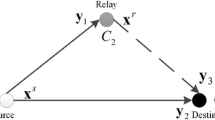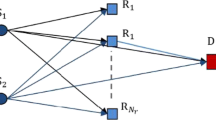Abstract
In this paper, we propose a Goppa coded-cooperative (GCC) diversity scheme for a single-relay setting where a source communicates with a destination with the help of a relay in a two-time-slot transmission. Two Goppa codes are distributed over the source and the relay terminals in order to construct a jointly designed channel code at the destination. In the multiple access phase, we consider an optimization design criterion at the relay, which is shown to greatly enhance the Bit Error Rate (BER) performance of the cooperative system. In this way, the source and the relay codes jointly contribute to building the best possible optimized code at the destination. To get the maximum coding gains from this joint construction, a joint decoding scheme is employed at the destination. We investigate the BER performance of the GCC diversity scheme for both the cooperative and non-cooperative schemes over the Rayleigh fading channel. Monte-Carlo simulations show that the proposed GCC scheme significantly outperforms the non-cooperation scheme.



















Similar content being viewed by others
References
Van Der Meulen, E. C. (1971). Three-terminal communication channels. Advances in Applied Probability, 3, 120–154.
Dai, B., Yu, L., & Ma, Z. (2016). Compress-and-forward strategy for the relay broadcast channel with confidential messages. In: 2016 IEEE International Conference on Communications Workshops (ICC). pages 254–259.
Ou, Q., Hou, X., Liu, F., Liu, Y., & Fang, S. (2018). Joint Partial Relay and Antenna Selection for Full-Duplex Amplify-and-Forward Relay Networks. In M. Huang, Y. Zhang, W. Jing, and A. Mehmood (eds), Wireless Internet. WICON 2016. Lecture Notes of the Institute for Computer Sciences, Social Informatics and Telecommunications Engineering, volume 214. Springer, Cham.
Laneman, J. N., Wornell, G. W., & Tse, D. N. (2001). An efficient protocol for realizing cooperative diversity in wireless networks. In: 2001 IEEE International Symposium on Information Theory. page 294.
Hunter, T. E., & Nosratinia, A. (2006). Diversity through coded cooperation. IEEE Transactions on Wireless Communications, 5(2), 283–289.
Fang, Y., Liew, S. C., & Wang, T. (2017). Design of distributed protograph ldpc codes for multi-relay coded cooperative networks. IEEE Transactions on Wireless Communications, 16(11), 7235–7251.
Mughal, S., Yang, F., & Ejaz, S. (2017). Asymmetric turbo code for coded-cooperative wireless communication based on matched interleaver with channel estimation and multi-receive antennas at the destination. Radio Engineering, 26(3), 878–889.
Zhan, Q., Minghui, D., Wang, Y., & Zhou, F. (2014). Half-duplex relay systems based on polar codes. IET Communications, 8(4), 433–440.
Blasco-Serrano, R., Thobaben, R., Andersson, M., Rathi, V., & Skoglund, M. (2012). Polar codes for cooperative relaying. IEEE Transactions on Communications, 60(11), 433–440.
Ejaz, S., & Yang, F. (2017). Jointly optimized Reed-Muller codes for multilevel multi relay coded-cooperative VANETS. IEEE Transactions on Vehicular Technology, 66(5), 4017–4028.
Ejaz, S., Yang, F., Xu, H. J., & Zhang, S. (2015). Jointly optimized multiple Reed-Muller codes for wireless half-duplex coded-cooperative network with joint decoding. IEEE Transactions on Vehicular Technology, 1, 115.
Almawgani, A. H. M., & Salleh, M. F. M. (2009). RS coded cooperation with adaptive cooperation level scheme over multipath Rayleigh fading. In IEEE 9th Malaysia International Conference on Communications, pages 480–484, Kuala Lumpur (Malaysia). IEEE Transactions on communication.
Bose, R. C., & Ray-Chaudhuri, D. K. (1960). On a class of error correcting binary group codes. Information and Control, 3(1), 68–79.
MacWilliams, F.J. and Sloane, N.J.A. (1977) The Theory of Error-Correcting Codes, volume 16 of North-Holland Mathematical Library, page iii. Elsevier.
Moreno, C. (1991). Algebraic curves over finite fields, in Cambridge Tracts in Mathematics 97. Cambridge Univ Press.
Tsfasman, M. A., Vladut, S. G., & Zink, T. (1982). On Goppa codes which are better than the Varshamov-Gilbert bound. Mathematische Nachrichten, 109, 21–28.
Sugiyama, Y., Kasahara, M., Hirasawa, S., & Namekawa, T. (1975). A Method for Solving Key Equation for Decoding Goppa Codes. Information and Control, 27(1), 87–99.
Sugiyama, Y., Kasahara, M., Hirasawa, S., & Namekawa, T. (1976). An Erasures-and-Errors Decoding Algorithm for Goppa Codes. IEEE Transactions on Wireless Communications, 22(2), 238–241.
Van Nguyen, T., Nosratinia, A., & Divsalar, D. (2013). Bilayer protograph codes for half-duplex relay channels. IEEE Transactions on Wireless Communications, 12(5), 1969–1977.
Acknowledgements
This work was supported by National Natural Science Foundation of China under the Grant Number 61771241.
Author information
Authors and Affiliations
Corresponding author
Ethics declarations
Conflict of interest
All authors declare that they have no conflicts of interest.
Additional information
Publisher's Note
Springer Nature remains neutral with regard to jurisdictional claims in published maps and institutional affiliations.
Rights and permissions
Springer Nature or its licensor holds exclusive rights to this article under a publishing agreement with the author(s) or other rightsholder(s); author self-archiving of the accepted manuscript version of this article is solely governed by the terms of such publishing agreement and applicable law.
About this article
Cite this article
Waweru, D.K., Yang, F., Zhao, C. et al. Design of optimized distributed Goppa codes and joint decoding at the destination. Telecommun Syst 81, 341–355 (2022). https://doi.org/10.1007/s11235-022-00948-5
Accepted:
Published:
Issue Date:
DOI: https://doi.org/10.1007/s11235-022-00948-5




